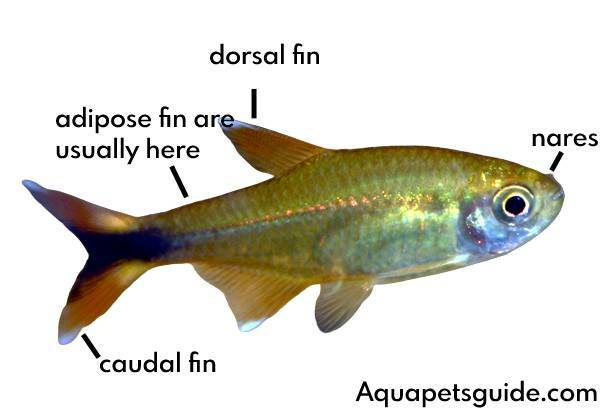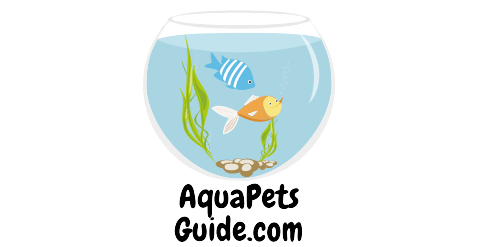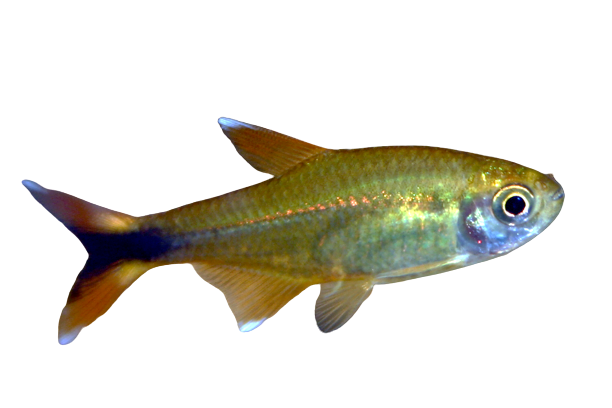
Silvertip Tetra, also known as Hasemania Nana (scientific name), belongs to the order Characiformes and the family Characidae. It got its name ‘’Hasmenia’’ from The Ichthyologist John D Hosman.
They are very popular freshwater community fish that can be added to your tank today since they are beginner friendly and easy to care for.
Additionally, they are plant-friendly and no picky eaters.
In their natural habitat, they usually feed on insects, insect larvae, micro microfauna, and basically anything they can find in the water’s benthic and surfaces.
They are omnivores by nature and will basically eat anything offered to them, especially food that floats on the surface of the water. They love that.
Their Origin
They are a very hard type of fish. They are used to surviving in harsh environments such as rocky clear water creek beads, muddy ph-low water areas, streams, and many other similar places.
Country of origin
They are native South American species of Tetras and can be found in Brazil, Colombia, and Peru streams.
However, most Silvertip Tetras that you can purchase nowadays in stores come from the Sao Francisco river in Brazil.
Habitat
They tend to inhabit creeks and tributaries connected to the main river channels, but they can also be found in both black and clear water environments. So given their natural range they can easily cohabit with many fish so it’s easy to set up a biotope with silvertip tetras in them.
Fish that live in the same environment
Some of the known species that exist in the same environment as Silvertip Tetra are:
Black phantom Tetras Marbled Hatchetfish Hpistogramma cacatuoides Cupid cichlid ( Biotodoma Cupido) Bloodfin tetra (Aphyocharax Anisitsi) Apistogramma elizabethae Bronze corydoras (corydoras aeneus)
Adding them to your Aquarium
As we have already mentioned at the beginning, they are very friendly as they are basically community fish so integrating them into your aquarium shouldn’t pose a problem.
Distinguishing between Males and Females
Males tend to have slender bodies and are mostly orange or golden in color. In contrast, females tend to have more of a light silvery appearance with rounder bodies especially when they are carrying their eggs.
Both males and females have white tips on the fins, that’s where they got their name from- Silvertip. It makes a completely beautiful scenery in the aquarium, especially under the right lighting, they are very active so you can see them swinging their silvery fins as they move.
Hasemonia Nana sometimes tend to lose their color as their bodies color becomes lighter and fades. Don’t worry too much about it, it can be easily remedied with color-enhancing food you can find at your local store
A quick tip:
Special Characteristics
Silvertip Tetras, also, like many other Hasemania species, differ from other Tetras as they lack an adipose fin which is located between the dorsal fin and the tail.
They also have a black patch at the base of their fish fins (caudal fins).

Tank Size
Normal tank size for Silvertip Tetras should range from 10 to 20 gallons (38-75 liters) if you have a small number of them.
The ideal Tank size otherwise should be more than 20 gallons (75 liters) at least with a nice setup. From my experience, they fit well in a 50-gallon (190-liter) tank.
Ph level
They tolerate a wide variety and are used to living in a neutral PH environment, so a PH of 6.0 to 8.0 could be ideal for them.
Temperature
A temperature of 72-75°F to 80 degrees Fahrenheit could be ideal for them.
Equivalent to approximately 22-25 °C to 27 Celsius degrees.
Size
1.2 inches which is equivalent to 3 centimeters and they can reach a maximal length of 2 inches (5cm) but not always so you don’t have to feel weird if their size remains the same.
Lifespan
Their lifespan ranges from 5 to 8 years. The average life expectancy is 5 years, but they can live for up to 8 years if they are taken proper care of.
Tank Mates
They get along with almost everyone from Cihlids to Minnows and Carps (Cyprinids), Rasbora species, and Golden small barbs who are sometimes known as dwarf barbs.
Hasemania Nana also gets along with many gourami species. They can also be grouped with Catfish and Loaches but you should make sure the tank is large enough to accommodate them so they won’t be eaten.
They can also be kept with nippy fish such as Black widow tetras and Tiger Barbs.
They can also be grouped with Angelfish and Discuss provided your aquarium is well-decorated and has plenty of hiding spots, rocks, and plants.
Diet
It’s recommended to feed them twice a day on a regular schedule, for example, one time in the morning and another time at night.
You can feed them live or frozen worms (they eat frozen food too) and genusus such as brine shrimp and daphnia (common water flea) or just regular staples of flake, pellets, and granular that you can find at the store as long as it’s varied.
They also get in a frenzy when they start eating, so don’t be surprised to see that each time you feed them.
Behavior
While most Silvertips are peaceful by nature, some people experience them being aggressive against each other in small groups of 2 to 6. They aren’t as aggressive as Piranhas, or as ”fighters” as Bettas. However, you’ll see them poking at each other sometimes until they tire and lay down, so it’s better to keep them in large groups of more than ten.
Ideally, it’s better to keep them in a group of twenty. This tends to decrease and ease the aggression between them while making them happier, more cheerful, colorful, and super active.
Watch them eating and moving around:
Don’t get more males than females. Because the males tend to chase after the females all the time in the tank, it’s better to keep a ratio of one male for every two or three females.
A quick tip:
Quick tip number 2:
The fewer Silvertip Tetras in the tank the more aggressive they become. Therefore, I’d recommend at least 10 Silvertip Tetras in a community tank so they won’t pick a fight with each other or with other fish.
Interacting with them
You can play with them. They are very interactive. You can try pointing your finger at the aquarium and moving it and you will see them gather toward it in a beautiful view.
You can do that if you like to see them moving and schooling around. This works better when there is a large number of them.
They are generally not expensive so people are easily attracted when the aquarist in the stores tells about them.
How to know if your fish is Sick?
Silvertip Tetra also gets sick but it’s usually not that serious. Common illnesses such as losing appetite, stress, white spots or fin rot can happen frequently.
The most common illness you should be aware of is neon tetra disease. As you can see from its name, it’s somehow related to tetras as it was first discovered in this type of race. However, it still spread to other types of fish too.
Here are some common symptoms of Neon Tetra disease
- The fish will start to lose its color: But as you’ve read above Silvertip tetras sometimes lose their colors just like that and that can be fixed with coloring food so you can’t diagnose it with only this.
- Agitation: you will notice that the fish is very agitated, be sure to read above so as not to confuse it with the silvertip tetra natural behavior.
- Curved spine: The fish can have their spin curved in severe cases
- Difficulty swimming: don’t confuse this with the fish being tired. Silvertip tetras are very active so they get tired.
- Bloating: this can be easily spotted if the fish is male but can be difficult t spot if it’s a female so be sure to assess carefully.
- Fin rot: you should check on them regularly
If you are at the store and you notice that the fish don’t exhibit any of these symptoms, don’t hesitate and get them!
Breeding
Like other Tetras, Silvertip are egg scatterers. This means they have no sense of responsibility for their eggs. Instead, they let them float around, randomly scatter and latch onto plants, and be buried in sand rocks.
They are regular breeders. If properly taken care of, you can expect them to breed multiple times as long as there are enough plants and hiding places where they can scatter the eggs.
Also, you should be aware that they have the tendency to eat their own eggs, basically the same as the other egg scatterers, so don’t be surprised if the number of eggs that hatch is just a little of that what you originally saw. Of course that can be avoided but usually in large tanks with many many nice plants around.
Hatching
The hatching of Silvertip Tetras usually doesn’t take that long. They usually hatch in a day or two and you can see the little ones swimming in about 3 to 5 days. However, be sure to get them enough specialized baby silvertip tetra food for the first few days before letting them eat the regular food that you give the others.
Summary
To sum it up, Silvertip Tetras are very nice to look at when they are in large numbers. Whether you already own a batch of them or plan to add them to your already existing tank. Be assured that they are very easy to take care of. You can expect them to start schooling around your tank the very same day you bought them. Although they are not picky about the environment or the food, you do need to take good care of them and feed them well if you want them to stay active and colorful.
FAQs
Q1.What is the ideal fish tank size?
There is no ideal size and their native places but still the larger the better so id recommends at least a medium tank with a 20-gallon (75 liters) setup.
Q2.How big do they get?
The usual size of the silvertip tetra is usually 1.5 inches (4cm) in its adult form and can grow up to 2 inches, but not all of them grow to 2 inches (5cm) and most of them stay at 1.5 inches approximately 4cm.
Q3.How many Silver-Tip Tetras should be kept together?
As they are a community fish the more of them in your tank the better.
The minimum number in an aquarium can be around 6-8 but be sure to have enough balance between males and females in a ratio of 2-3 females to one male. Otherwise, be expected to see them fighting all the time.
Q4.Are Haseminia Nanas peaceful?
They are peaceful. But they can also be aggressive, it depends on how you set them up. When they are in a group of twenty and more you are gonna see less skirmish between them.
Q5.How long do Silver Tip Tetras live?
Silvertip tetra lives 5 years on average but it could live up to 8 years as long as it they are well attended.
Q6.Can I feed Them once a day?
Silvertip Tetras love to eat so it’s recommended to feed them twice a day on a regular basis(once in the morning and once at night). If they are not properly fed you are gonna notice that their natural color is fading.
Q7. Can you keep 4 Silver tetras together?
You can but I don’t recommend it. Group them at least in a group of 6.
I hope you find this post about these beautiful and docile fish informative and helpful. If you have any thoughts or questions about the topic, please don’t hesitate to leave a comment below or contact us from the contact page, I’d love to hear your feedback and start a chat with you.
You can also share our Article on Social Media from the icons below


5 thoughts on “Silvertip Tetra Care: All You Need To Know”